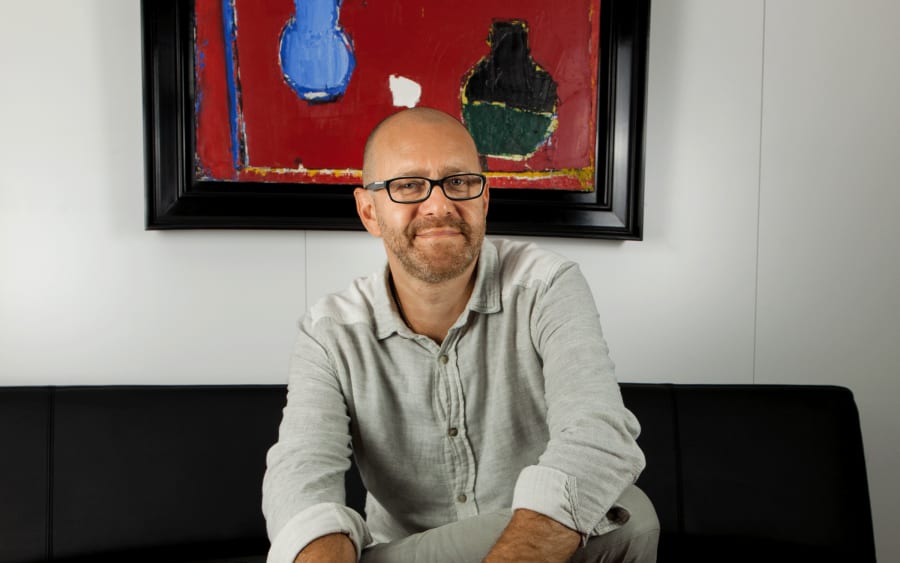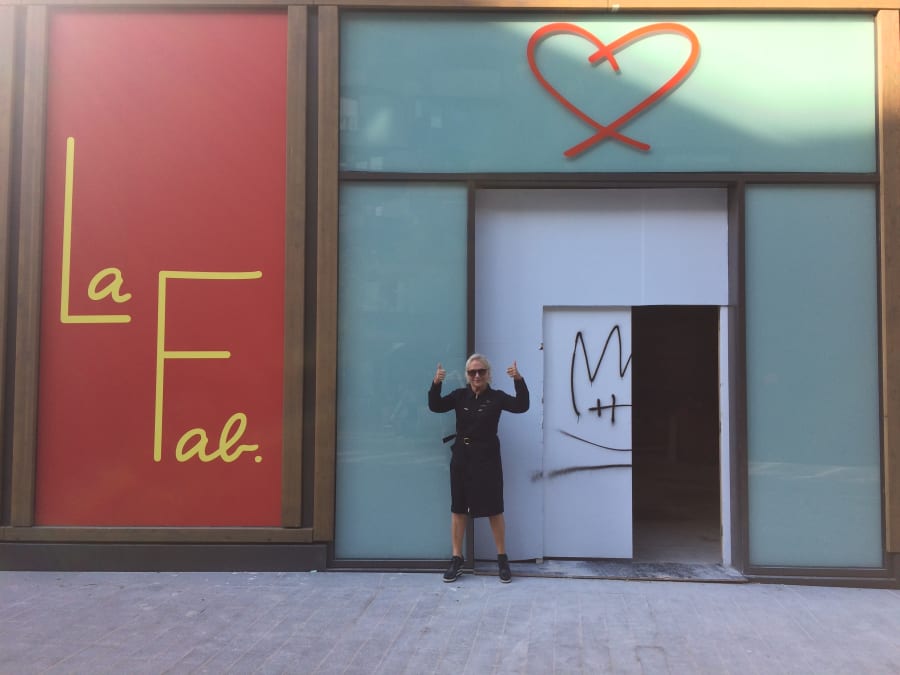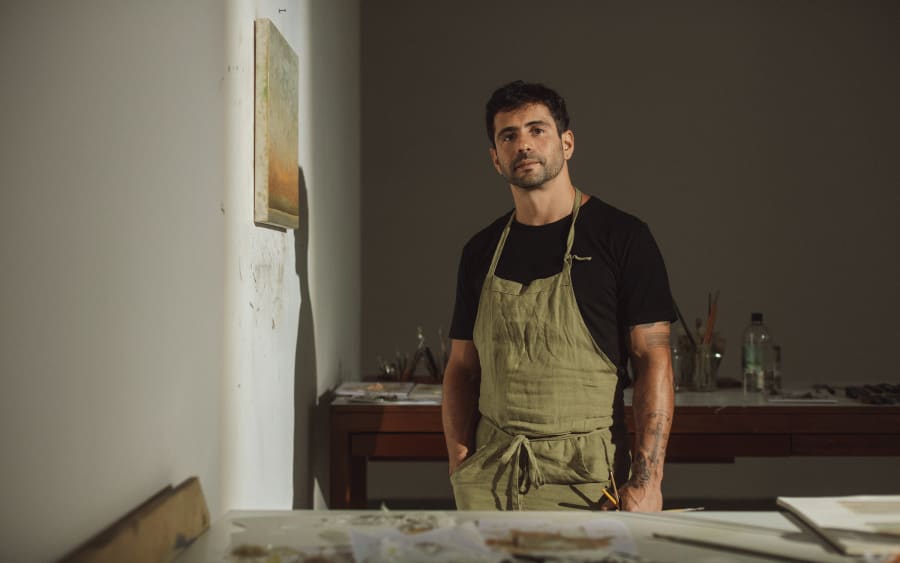Modernism transformed painting into a laboratory of experimentation, with abstraction marking a decisive break from the figurative tradition. At the heart of this movement in the Postwar era stood Georges Mathieu (1921–2012), who occupied a singular position. The self-proclaimed founder of Lyrical Abstraction, Mathieu developed, as an autodidact, a practice where gesture reigns supreme – instantaneous and irrevocable. However, he long remained at the margins of the dominant narrative, eclipsed by his American contemporaries.
More than a decade after his death, the Monnaie de Paris [the French national mint] has partnered with Centre Pompidou to present a retrospective dedicated to Mathieu (April 11 to September 7). The exhibition is among the first in the Pompidou’s off-site program, organized ahead of the museum’s planned closure for renovation.
Édouard Lombard, the director of the Comité Georges Mathieu, has welcomed these posthumous rehabilitation efforts: ‘Mathieu’s work has long suffered from prejudice in France. People were already talking about a release from purgatory in the 2000s; it was a long journey, but I believe he has finally escaped.’ This rediscovery is part of a broader recognition championed by the committee, which works to elevate his standing on the global art scene. Last year, it oversaw the artist’s first Asian retrospective at Shanghai's Long Museum.
‘The market is proving us right,’ says Lombard, pointing to the artist’s rising value in recent years. As early as 2018, Hommage au Connétable de Bourbon (1959), a monumental 6-meter-wide canvas, made an impression at Art Basel in Switzerland. Its inclusion in the Unlimited sector, rare for a Modern painting, underscored its performative nature. Executed in less than 40 minutes during a musical performance with Pierre Henry at Vienna’s Fleischmarkt Theater in 1959, the drama of its composition captivated viewers, with striking bursts of purple, yellow, and white entangled against a background of deep blues.
For Franck Prazan, who presented a booth dedicated to Mathieu at Art Basel Paris in 2022, this renewed interest reflects a broader reinterpretation of postwar painting. ‘Mathieu has always had his collectors – in Asia, the United States, even the Middle East. His work transcends cultural boundaries,’ he explains. ‘But these buyers didn’t necessarily have the profile of today’s collectors, who invest in major works.’
Éric de Chassey, the director general of the Institut National d’Histoire de l'Art, is delighted to exhibit Mathieu at the Monnaie de Paris: ‘The institution wanted to refocus on exhibitions related to its collections and industrial activity. It happens that one of the first art exhibitions organized here was by Mathieu.’ That was in 1971. Drawing on the collections of the Musée National d’Art Moderne, the retrospective explores the artist’s complete body of work, divided into 10 themes: ranging from works inspired by medieval history to Japanese-influenced experiments, and Zen aesthetics. Large canvases inspired by great battles, such as Les Capétiens partout! (1954) and La Bataille de Bouvines (1954), appear alongside more refined creations, such as Karaté (1971), before a notable shift to figuration – unique in Mathieu’s oeuvre – with La Libération d’Orléans par Jeanne d’Arc (1982).
Rather than a celebration of artistic genius, the curation aims to be lucid and uncompromising. ‘I’m not interested in heroic monographs,’ says de Chassey. ‘The theories espoused by Mathieu have engendered a very pontificating reading of his work, which, in my view, is neither entirely false nor entirely accurate. There’s a much more ambiguous and contradictory aspect to his work that I hope to bring to light.’ Mathieu commented extensively on his own practice, developing theories that mixed art history with concepts from philosophy and quantum physics.
Behind the image of an eccentric dandy, polemicist, and royalist emerges the legacy of an unclassifiable artist. Prolific, Mathieu did not limit himself to painting. He ventured into applied arts, designing the 10-franc coin – a genuine popular icon and his most widely distributed work, minted in over 600 million copies from 1974. He also collaborated with the Sèvres porcelain factory and designed posters for Air France.
One must see Mathieu at work to grasp the explosiveness and frenzy that inhabits his canvases, which the exhibition traces through films and previously unseen archives of his performance-creations. Guided by emotion, the urgency of gesture, and risk, the artist would pour color directly from the tube. For Lombard, his art also represents ‘an act of generosity,’ a desire to share.
The exhibition also revisits the dialogue between artists. Paintings by Jackson Pollock and Wols feature along the exhibition path. Mathieu was a conduit for ideas, playing a key role in transatlantic intellectual exchanges. For 10 years, he edited the magazine United States Lines Paris Review, where he invited Dalí, Cage, and Duchamp to contribute, and introduced European audiences to American Abstract Expressionists (including Tobey, de Kooning, Gorky, Reinhardt, and Rothko) as early as the late 1940s.
Mathieu thus weaves connections between eras. His work Les Nymphes de Diane (1971), inspired by a Rameau ballet, was designed specifically for the grand staircase of the Monnaie de Paris, where it now returns for the first time since 1971. Also, echoing his legacy, figures from contemporary graffiti – JonOne, Lek and Sowat, Nassyo, Camille Gendron, and Matt Zerfa – have been invited to create on-site interventions. A fitting affirmation for an artist that, far from belonging to the past, continues to provoke fascination and debate.
Georges Mathieu's estate is represented by Templon (Paris, Brussels, New York), Perrotin (Paris, Hong Kong, London, Los Angeles, New York, Seoul, Shanghai, Tokyo), Applicat-Prazan (Paris), Mazzoleni (Turin, London), Galerie Pascal Lansberg (Paris), and Nahmad Contemporary (New York).
Georges Mathieu
From April 11 until September 7, 2025
Monnaie de Paris
Paris
Tifenn Durand is an art enthusiast and a master’s student at Sciences Po Paris. She is a regular collaborator of Art Basel’s Editorial team.
English translation: Art Basel.
Published on April 10, 2025.
Caption for header image: Georges Mathieu, La Bataille de Bouvines, 1954. Collection Centre Pompidou, Paris Musée national d’art moderne, Centre de création industrielle. Credit: Centre Pompidou, MNAM-CCI/Bertrand Prévost/Dist. Grand Palais RMN. © Adagp, Paris, 2025


